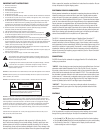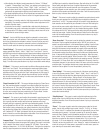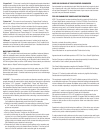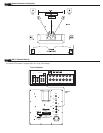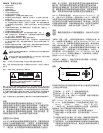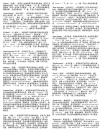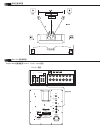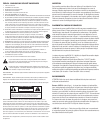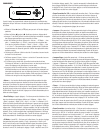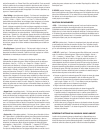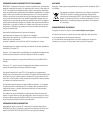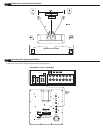“Keypad Lock” - This screen is used to lock the keypad and prevent unintentional
changes to your settings by other users. After making all desired adjustments press
the Enter key to lock the keypad. “Keypad Locked Hold to Unlock” will be displayed.
The display will then return to the default “Volume” screen after about 20 seconds.
To unlock the keypad press and hold the Left and Right until the display returns to
the “Volume” screen. The keypad is now unlocked. It is suggested that you write
down all of your settings for future reference in case the keypad is unlocked and
your settings are changed by another user.
“System Info” - This screen is used to access the “System Reset” function to
clear all user settings and memories (refer to the “Save Settings” section of this
manual). If the “System Reset” function is activated all of the memory presets
are erased and the subwoofer’s controls are restored to the default settings of
– “Volume 0dB”, “EQ Mode Flat”, “Lowpass OFF LFE Mode”, ”Phase 0°”, “Disp
Brightness” (highest level) and “Power Always On”. For more information on the
controls mentioned in this manual and on the bass management settings of your
electronics, see your authorized Klipsch dealer or visit www.klipsch.com.
“IR Sensor” - An infrared remote control sensor is included on the top of your
subwoofer for integration with A/V remote control systems. The IR codes for this
subwoofer can be obtained by visiting www.klipsch.com. A dedicated hand held
remote control does not exist for these models.
BACK PANEL FEATURES
“USB” - This computer interface allows access to additional advanced features
within the subwoofers room correction software. Optional, proprietary Klipsch
software and a higher level of technical knowledge are required to correctly utilize
this capability. This port can also function as an alternative control interface with
A/V Control systems that can utilize a USB hookup. Please contact your authorized
Klipsch dealer or Klipsch Technical support for more information.
“MIC IN” - Plug the supplied microphone into this jack when using the “ROOM
CORRECTION” feature during setup. It is recommended that the microphone be
disconnected and stored in a remote location during normal use to avoid damage
from loud playback levels.
“LINE OUT” - This connection can be used as an alternate connection point for a
second subwoofer. Be aware that the signal output from these jacks is effected by
the “Volume”, “EQ”, “Lowpass”, “Lowpass Slope”, “Phase” and “Room Correc-
tion” settings of your SW subwoofer. The advantage of this is the ability of the
SW subwoofers Adaptive Room Correction function to correct the response the
second subwoofer, resulting in a more accurate response. If the secondary sub-
woofer is connected directly to your system, the SW subwoofer’s room correction
will react to rather than control the response of the other subwoofer. As a result
we recommend the following procedure when connecting a second subwoofer to
these outputs.
• Play a signal, through the SW subwoofer and set the volume control of the
2nd subwoofer to approximately match that of the SW subwoofer.
• Defeat the secondary subwoofer’s low pass setting by selecting the “Bypass”
or “LFE” mode or set the low pass control to its highest frequency if these
options are not present.
• Set the secondary subwoofer’s phase control to 0°
• Run the “Room Correction” function on the SW subwoofer
• As with the initial setup of your SW subwoofer, listen to a track with a repeat-
ing bass line in your listening position. Experiment with alternate phase set-
tings on the secondary sub while repeating this track. If one of these alternate
settings yields an increased amount of bass, choose that setting and run the
SW subwoofer’s room correction function again.
• Please note that if either the volume or phase settings on the secondary sub
are changed after running the Adaptive Room Correction™ function you will
have to run the SW subwoofer’s room correction again to compensate.
CARE AND CLEANING OF YOUR POWERED SUBWOOFER
Your subwoofer has a durable black satin finish that should only require dry dust-
ing or cleaning with a dry cloth. Avoid the use of abrasive or solvent-based clean-
ers and harsh detergents. The brush attachment of your vacuum should remove
any dust from your subwoofer enclosure.
FCC AND CANADA EMC COMPLIANCE INFORMATION
NOTE: This equipment has been tested and found to comply with the limits for
a Class B digital device, pursuant to part 15 of the FCC Rules. These limits are
designed to provide reasonable protection against harmful interference in a
residential installation. This equipment generates, uses and can radiate radio
frequency energy and, if not in-stalled and used in accordance with the instruc-
tions, may cause harmful interference to radio communications. However, there
is no guarantee that interference will not occur in a particular installation. If this
equipment does cause harmful interference to radio or television reception, which
can be determined by turning the equipment off and on, the user is encouraged
to try to correct the interference by one or more of the following measures:
Reorient or relocate the receiving antenna.
Increase the separation between the equipment and receiver.
Connect the equipment into an outlet on a circuit different from that to which the
receiver is connected.
Consult the dealer or an experienced radio/TV technician for help.
Approved under the verification provision of FCC Part 15 as a Class B Digital Device.
Caution: Changes or modifications not expressly approved by the manufacturer
could void the user’s authority to operate this device.
This Class B digital apparatus complies with Canadian ICES-003.
Cet appareil numérique de la classe B est conforme à la norme NMB-003 du Canada.
The term “IC:” before the radio certification number only signifies that Industry
Canada technical specifications were met.
This equipment complies with FCC and IC radiation exposure limits set forth for
an uncontrolled environment. This equipment should be installed and operated with
minimum distance 20cm between the radiator and your body. This transmitter must
not be co-located or operating in conjunction with any other antenna or transmitter.
Le terme «IC:» avant le numéro de certification radio signifie seulement que les
spécifications techniques d’Industrie Canada ont été respectées.
Cet appareil est conforme à FCC et IC l’exposition aux rayonnements limites
fixées pour un environnement non contrôlé. Cet appareil doit être installé et utilisé
avec une distance minimale de 20 cm entre le radiateur et votre corps. Cet trans-
metteur ne doit pas être co-situé ou opérant en liaison avec toute autre antenne
ou transmetteur.
Operation is subject to the following two conditions: (1) this device may not cause
interference, and (2) this device must accept any interference, including interfer-
ence that may cause undesired operation of the device.
To reduce potential radio interference to other users, the antenna type and its gain
should be so chosen that the equivalent isotropically radiated power (e.i.r.p.) is not
more than that permitted for successful communication.





